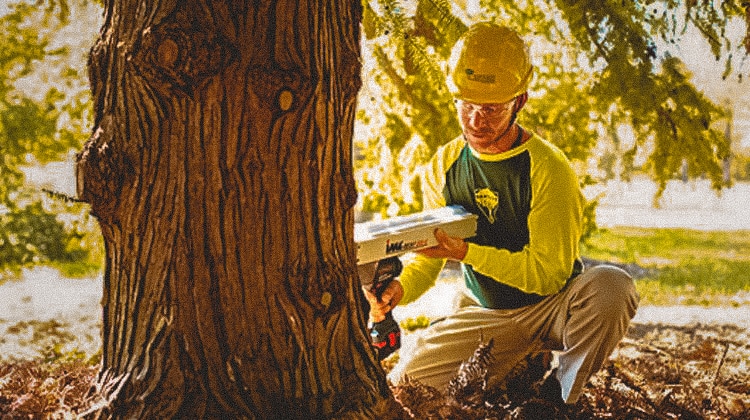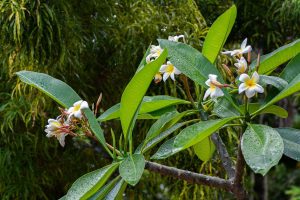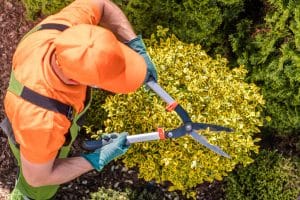Mistletoe, that happy and heartfelt plant frequently connected with occasion kisses, can be an enchanting expansion to your occasional style. In any case, when it finds its direction onto your trees, it changes from an image of affection into a parasitic danger to your darling plant life. In this blog entry, we’ll dig into the universe of mistletoe, investigating its effect on trees and directing you through the fundamental stages for its successful expulsion. Mistletoe isn’t your common plant. A special and rather secretive living being flourishes in a particular manner. Mistletoe is a gathering of plants having a place with the Viscaceae family, known for their capacity to parasitize trees and bushes. Dissimilar to most plants that fill freely in the dirt, mistletoe grows and joins itself to the parts of host trees, where it lays out a parasitic association. This relationship permits mistletoe to draw supplements and water straightforwardly from its host, debilitating the tree over the long run. Mistletoe isn’t simply an occasional enhancement or the wellspring of occasion customs; it’s a genuine danger to the wellbeing and life span of your trees.
Understanding remove mistletoe from trees
What is Mistletoe?
Mistletoe, a plant with exceptionally old practices related with adoration and special festivals, is very extraordinary in its way of life. Mistletoe has a place with the Viscaceae family and has around 1,300 species around the world. Not at all like most plants that fill in the dirt, mistletoe sprouts on the branches or trunks of host trees and bushes. It forms a parasitic association, permitting it to infer water and supplements straightforwardly from its host.
Various Sorts of Mistletoe and Their Impacts on Trees
There are a few types of mistletoe, and their effect on trees can differ. Two normal kinds of mistletoe found in North America are the Eastern mistletoe (Phoradendron leucarpum) and the Bantam mistletoe (Arceuthobium spp.).
Eastern Mistletoe (Phoradendron leucarpum):
- This species is known for its notable appearance with green leaves and white berries.
- It will in general be less harming to have trees contrasted with bantam mistletoe.
- Eastern mistletoe is commonly found in hardwood trees, like oaks and maples.
Bantam Mistletoe (Arceuthobium spp.):
- Bantam mistletoe is a gathering of animal varieties known for their more modest size and ruddy earthy colored berries.
- It is more damaging than the Eastern mistletoe and principally contaminates coniferous trees like pines and firs.
Signs and Side effects of Mistletoe Pervasion
Bunches of Plant life: Mistletoe shows up as unmistakable groups of green leaves and stems on tree limbs.
Berries: Some mistletoe species produce berries, which can be white, red, or different tones relying upon the species.
Dieback: Swarmed branches might show dieback, where the foliage becomes yellow or brown, and the branches become powerless.
Strange Development Examples: Mistletoe can cause misshapen and sporadic development on the host tree.
Diminished Energy: Pervaded trees might give indications of decreased development and by and large wellbeing.
Getting ready to remove mistletoe from trees
Assemble Essential Devices and Security Hardware
Pruning Instruments: You’ll require a sharp set of pruning shears or loppers to remove the mistletoe. Guarantee your apparatuses are perfect and appropriately kept up with.
Security Stuff: Wellbeing ought to be fundamentally important. Wear gloves, wellbeing glasses, and a long-sleeved shirt to safeguard yourself from likely aggravations in the mistletoe sap or garbage.
Stepping stool or Post Pruner: Contingent upon the level of the mistletoe-pervaded branches, you might require a durable stepping stool or a post pruner with an expansion shaft to securely arrive at higher regions.
Pails or Coverings: These will be convenient for gathering and discarding the eliminated mistletoe branches and berries.
Garbage sacks: Have a stockpile of garbage sacks for the removal of pruned mistletoe. Make certain to appropriately discard them.
Picking the Perfect Opportunity for Removal
Timing is pivotal with regards to mistletoe evacuation. The best chance to eliminate mistletoe is during the tree’s lethargic season, normally in pre-winter or late-fall when the mistletoe is apparent, and the tree isn’t effectively developing. During this period, the tree is less anxious, and the expulsion cycle is more averse to hurting it. Abstain from eliminating mistletoe during the developing season as it can put superfluous weight on the tree.
Recognizing the Kind of Mistletoe
Leaves and Berries: Look at the leaves and berries of the mistletoe. Is it green with white berries (Eastern mistletoe) or more modest with rosy earthy colored berries (Bantam mistletoe)?
Have Tree: Observe the kind of tree facilitating the mistletoe. Eastern mistletoe is in many cases found on hardwood trees, while Bantam mistletoe ordinarily taints coniferous trees.
Knowing the sort of mistletoe will assist you with fitting your expulsion approach for the best outcomes.
Strategies for how to remove mistletoe from trees
Pruning and Cutting
- Start by sanitizing your pruning devices with a sanitizer or scouring liquor to forestall the spread of illnesses.
- Cautiously eliminate the whole mistletoe branch, guaranteeing you cut something like 12 inches (30 cm) underneath the place where the mistletoe connects to the tree. This helps eliminate stowed pieces of the mistletoe and forestall regrowth.
- Make perfect, skewed slices to deter water from pooling on the cut surface.
- Abstain from tearing or harming the tree’s rind during the interaction.
- Position the pruning instrument right external to the collar (enlarged region) where the mistletoe associates with the host branch.
- Make a perfect, slanting cut, so water empties away out of the injury.
- Discard the pruned mistletoe in a fixed pack to forestall any possible reinfestation.
Herbicides and Synthetic Medicines
- Select a fitting herbicide in light of the kind of mistletoe and the host tree. Glyphosate-based herbicides are viable for some types of mistletoe.
- Adhere to the producer’s guidelines for weakening and application cautiously.
- Wear fitting wellbeing gear, including gloves and defensive eyewear.
- Apply herbicides during quiet, windless days to forestall float onto non-target plants.
- Be mindful about the likely effect of herbicides on the general climate and talk with neighborhood guidelines.
Organic Control Strategies
- A few birds, bugs, and organisms are normal foes of mistletoe. For example, Phoradendri wasps and mistletoe birds feed on mistletoe berries.
- Drawing in these regular hunters to your area can assist with controlling mistletoe.
- Plant local trees and bushes that draw in mistletoe-eating birds and bugs.
- Make bird-accommodating environments with feeders and water sources.
Mix Approaches
- As a rule, consolidating techniques for the best results is prudent.
- For instance, you can prune away the noticeable mistletoe branches and afterward circle back to a herbicide treatment on the excess parts.
- Recall that the decision of strategy might rely upon elements like the degree of invasion, the kind of mistletoe, and the general well being of the host tree. Continuously focus on the soundness of the tree during the expulsion cycle.
How to remove mistletoe from trees
Pruning and Cutting
Assemble your devices: Guarantee your pruning shears or loppers are spotless and sharp. Wear security gear, including gloves and defensive eyewear.
Distinguish the mistletoe: Find the mistletoe bunches on your tree. Distinguish where the mistletoe interfaces with the host branch.
Take care of business: Position your pruning device right external to the collar where the mistletoe is appended. Make a perfect, inclining cut, guaranteeing it is no less than 12 inches (30 cm) underneath the mark of connection. Eliminate the whole mistletoe branch.
Discard the pruned mistletoe: Place the pruned mistletoe in a fixed sack to forestall reinfestation. Try not to leave it close to the tree.
Herbicides and Substance Medicines
Pick the right herbicide: Select a proper herbicide in view of the kind of mistletoe and host tree. Peruse and adhere to the producer’s guidelines for weakening and application.
Security precautionary measures: Wear defensive stuff, including gloves and defensive eyewear. Pick a quiet, windless day for application to forestall herbicide float.
Application: Blend the herbicide as coordinated. Apply the herbicide to the mistletoe, guaranteeing total inclusion. Try not to shower the herbicide on non-target plants.
Follow-up: Screen the tree for indications of regrowth. On the off chance that it is vital, rehash the herbicide treatment according to the producer’s suggestions.
Organic Control Techniques
Make bird-accommodating living spaces: Draw in birds that feed on mistletoe berries by giving bird feeders and water sources in your nursery.
Plant local trees and bushes: Remember local species for your finishing, as they might have normal hunters of mistletoe.
Screen for indications of normal control: Notice the way of behaving of birds and bugs in your nursery. Some might show an interest in mistletoe berries.
Mix Approaches
Begin with pruning: Eliminate noticeable mistletoe groups utilizing pruning shears, following the means referenced before.
Herbicide treatment: In the wake of pruning, consider applying herbicides to the leftover pieces of the mistletoe, particularly in the event that it’s a constant pervasion.
Organic control: Energize normal hunters by establishing bird-accommodating conditions and establishing local species, which can supplement the other expulsion strategies.
Post-Removal Mistletoe Care from trees
When you’ve effectively eliminated mistletoe from your trees utilizing the techniques framed in the past area, it’s fundamental to give present evacuation care to guarantee the continuous wellbeing and imperativeness of your trees.
Checking the Tree’s Wellbeing
Examine consistently: Watch out for the tree for any indications of mistletoe regrowth. Check for groups of green leaves and berries, which might show a resurgence of mistletoe.
Watch for tree pressure: Focus on any progressions in the tree’s wellbeing. Search for indications of decreased energy, dieback, or underlying issues, as these could be signs of mistletoe-related harm.
Act expeditiously: Assuming that you notice any mistletoe regrowth or indications of stress, make a quick move to resolve the issue. Early mediation can forestall further harm.
Forestalling Future Mistletoe Invasions
Plant safe tree species: Assuming you’re finishing or establishing new trees, consider picking species that are less vulnerable to mistletoe invasions. Local species, at times, are normally safe.
Routinely assess trees: Lead routine assessments of your trees, particularly during the torpid season. Early location can make the evacuation cycle more reasonable.
Oversee close by have trees: Assuming you have adjoining trees that are mistletoe-plagued, consider working with your neighbors to by and large resolve the issue. Mistletoe can spread effectively starting with one tree then onto the next.
Prune adjoining trees: Pruning mistletoe-invaded branches from adjacent trees can decrease the gamble of mistletoe spreading to your trees. Urge your neighbors to do likewise.
Pruning and Upkeep Tips
Prune with care: While performing routine tree pruning, follow best practices to limit weight on the tree. Abstain from over-pruning, and make clean cuts.
Treat and water appropriately: Guarantee your trees get sufficient supplements and water to advance by and large wellbeing and flexibility.
Counsel an arborist: On the off chance that you’re questionable about the prescribed procedures for tree care, or on the other hand assuming your tree gives indications of stress, consider counseling an expert arborist. They can give master direction and administrations to assist with keeping up with your tree’s wellbeing.
FAQs
What season is best for eliminating mistletoe from trees?
The best time for mistletoe expulsion is during the tree’s lethargic season, commonly in pre-winter or late-fall. During this period, the tree is less anxious, and the expulsion cycle is more averse to hurting it.
Could I at any point utilize regular hunters to control mistletoe perversions?
Indeed, you can support normal hunters, for example, mistletoe-eating birds and bugs, to assist with controlling mistletoe. Establishing local trees and making bird-accommodating environments in your nursery can draw in these helpful living beings.
How frequently would it be advisable for me to review my trees for mistletoe?
It’s prudent to direct routine reviews of your trees, particularly during the lethargic season. Consistently check for indications of mistletoe invasions to get them early and forestall further harm.
Might I at any point utilize any herbicide to eliminate mistletoe, or are there explicit ones I ought to utilize?
Explicit herbicides turn out best for mistletoe expulsion. Glyphosate-based herbicides are frequently successful, however it’s critical to pick the right one in light of the kind of mistletoe and host tree. Continuously adhere to the producer’s guidelines for weakening and application.
Is mistletoe evacuation a one-time process, or would it be a good idea for me to hope to rehash it?
Mistletoe evacuation could require persistence and rehashed endeavors. Customary checking and follow-up activities are fundamental, as mistletoe can regrow. The objective is to keep up with your trees’ wellbeing and keep mistletoe under control.
Conclusion
Mistletoe might be charming during the holidays, but it poses serious threats to trees if left unchecked. It can sap tree vitality, cause structural damage, and even lead to tree death. However, armed with knowledge on identification, removal techniques, and post-removal care, you can protect your trees. As a tree enthusiast, you have the power to ensure their health and beauty for years to come. Don’t let mistletoe compromise your trees’ well-being; take action now. By staying vigilant, removing mistletoe when needed, and nurturing your trees, you can secure their longevity. Your efforts today will ensure that these trees continue to provide shade, oxygen, and beauty for generations. Thank you for joining us on this journey to safeguard trees from mistletoe. Your insights and experiences shared in the comments can help others facing similar challenges in tree care. Here’s to a mistletoe-free and thriving future for you and your trees!




